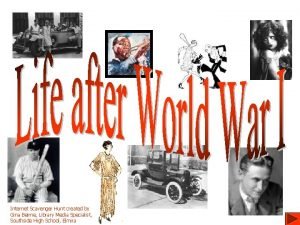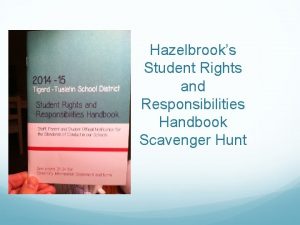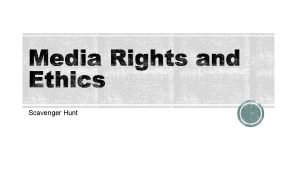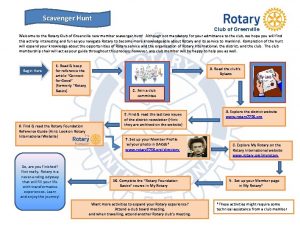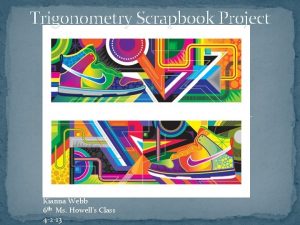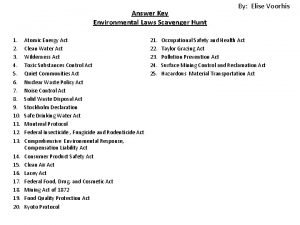Photo Scavenger Hunt Analyze photo Using pages 552

















- Slides: 17


Photo Scavenger Hunt • Analyze photo • Using pages 552 -563 and 598 -605, attempt to identify the historical event captured in the picture. • Describe the picture – identify who is in the picture • Give pages numbers in book







Overview • • Ending Vietnam Presidency of Richard Nixon Watergate Scandal Energy Crisis and the Middle East Affirmative Action Camp David Accords Iran Hostage Crisis

Vietnamization • President Richard Nixon plan for Vietnam • Encourage the South Vietnamese to take more responsibility for fighting the war while gradually withdrawing U. S. troops • Ordered troops into Cambodia to stop flow of communist supplies • Anti-war activism increased • January 1973 – Paris Peace Accords – cease fire and U. S. troop withdrawal United States: 35, 957 KIA 102, 270 WIA 240 MIA Fear of “another Vietnam” has had profound affects on foreign policy decisions

Nixon and Cold War Détente replaced previous policy of suspicion and distrust. 1972 – Nixon visited China to establish



Affirmative Action: government policy designed to redress past discrimination against women and minority groups through measures to improve their economic and educational opportunities. Strongly Disagree I Neutral I Agree I Strongly Agree

Affirmative Action http: //www. pbs. org/now/shows/434/video. html 11: 55 a. Did any of the arguments presented in the video affect your previous views on affirmative action? Why or why not? b. From what you saw in this video, which side do you feel has the strongest argument and why? c. How would you describe the argument that affirmative action poses discrimination against whites and white males? d. How can the argument be made that affirmative action does more harm than good for women and minorities? e. Do you feel the drop in minority enrollment in California universities is due to the states elimination of affirmative action policies or other factors? Explain your answer.

• • Fishbowl Instructions: a. Divide students into 5 groups. b. Ask all students to arrange their desks or chairs into a single file circle in the middle of the room. c. Have the first group sit facing each other in the center of the circle. d. Explain to students that in a fishbowl discussion, only the students in the center of the circle are allowed to speak. Students on the outside circle should be listening closely and referring to their notes. When a student from the outer circle wants to contribute to the discussion, he or she moves to the group in the middle and taps a participant to indicate that he or she want to take their place in the discussion circle. e. After discussing the first question, bring in the second reading group for the second question and conduct the activity in the same way. Be sure to switch groups every time you move to another question to make sure all students have an opportunity to be in the center discussion circle at least once. Fishbowl Questions 1. Has race-based affirmative action as achieved its goals of redressing past discrimination to improve minorities' economic and educational opportunities? Explain. 2. Race-based affirmative action promotes diversity, but does it promote equality of opportunity? If so, how? If not, explain why it should or shouldn't be continued. 3. Explain what you think will be the effect of the elimination of race-based affirmative action programs. 4. Is class-based affirmative action a better way to address the needs of the disadvantaged? Explain. 5. Is the question of race-based versus class-based affirmative action and "either/or" proposition? Can both be used or is one policy better than the other?

• Munich • AA Flight 191 - May 25, 1979 • Charles Manson
 Printed pages vs web pages
Printed pages vs web pages Curriculum scavenger hunt
Curriculum scavenger hunt Scavenger hunt dream meaning
Scavenger hunt dream meaning Five effects of the great depression
Five effects of the great depression Driver's handbook scavenger hunt answer key
Driver's handbook scavenger hunt answer key Kitchen equipment scavenger hunt answers
Kitchen equipment scavenger hunt answers Soil scavenger hunt
Soil scavenger hunt Psalms 22 meaning
Psalms 22 meaning I am the first element in the fourth period
I am the first element in the fourth period Student handbook scavenger hunt
Student handbook scavenger hunt Iceland scavenger hunt
Iceland scavenger hunt Media rights and ethics scavenger hunt
Media rights and ethics scavenger hunt Proportions scavenger hunt
Proportions scavenger hunt Biology
Biology Data scavenger hunt
Data scavenger hunt Scavenger hunt greenville
Scavenger hunt greenville Scavenger hunt google slides
Scavenger hunt google slides Trig ratio scavenger hunt
Trig ratio scavenger hunt



